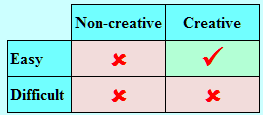A BRIEF HISTORY
AIMS OF THE CHALLENGE
THE NATURE OF THE CHALLENGE
FORMAT AND ORGANISATION OF THE CHALLENGE
ORGANISATION
A BRIEF HISTORY
In 1977 Mona Leeuwenburg initiated, organised and ran a "mini-mathematics" competition for Grade 7 learners in the Cape Peninsula. It proved to be popular with both learners and teachers and became an annual event. In 1985 MASA, one of the ancestors of AMESA, with the assistance of the then teachers' centres helped to organise the Mathematics Competition in other regions. In 1986 the Competition was extended to other grades. In 1995 the name was changed to the AMESA Mathematics Challenge. In 2011 AMESA requested SAMF to handle the administration of the Challenge, while AMESA gives academic leadership (e.g. about the nature of the questions) and AMESA still organises locally.
AIMS OF THE CHALLENGE
The Challenge is not an end in itself, but is intended as a vehicle to enhance the quality of the teaching and learning of mathematics.
More specifically, the Challenge aims
THE NATURE OF THE CHALLENGE
Given these objectives it should be clear that the Challenge is not at all intended as yet another scholastic test. The Challenge questions are aimed at conceptual knowledge, the application of knowledge in new situations, problem solving, reasoning, communication and general mathematical thinking. We want the Challenge to help South Africans to become empowered independent creative and critical thinkers! And we believe mathematics is accessible to all, not just the select few!
The Challenge is actually not about competition or about standards, but about participation, and we want learners to enjoy participating in the Challenge. We recognise that learners may initially find the questions quite challenging - hence the name Mathematics Challenge! But the questions are not necessarily "difficult" - they simply address a different dimension of mathematics of which our learners in the traditional curriculum have very little experience.
We work with the following matrix as guide in designing questions:

We try to set questions that are easy but creative, rather than difficult but non-creative.
Here is an example of the difficult non-creative category that we avoid:
![]()
Here is an example of an easy creative problem that we promote:
|
This flag has 7 regions. You want to colour the flag so that no two touching regions are the same colour. What is the least number of colours you need? |
|
The Challenge aims at giving learners experience of such problems. The more experience learners have of such non-routine problems, the more successful they will be in the Challenge, and the more we will achieve our objectives.
Click here for some sample questions.
THE FORMAT AND ORGANISATION OF THE CHALLENGE
The Challenge consists of a First Round, Second Round and a Final Round.
The First Round is written in schools on a specific date determined by the organisers (see below), at a time as arranged by the school. There are separate papers for Grade 4, 5, 6 and 7 set by a Problem Committee. Each paper is an hour long and consists of 20 multiple choice questions. First Round papers are distributed only by e-mail to Regional Organisers, who then distribute it to schools in their region. Schools make copies of the papers for their learners.
Given the aims and nature of the Challenge, we encourage schools to let all learners participate in the First Round. There are two categories of participation in each grade: more confident learners may prefer to participate as individuals (singles), whilst others may prefer to work in pairs (doubles).
Teachers mark the answers themselves from the memorandum we provide. Or the class may mark it during a class discussion!
The Second Round is for learners who achieved 50% or more in the First Round. There are again separate multiple choice papers for each grade and the duration is one hour. Learners participate only as singles. It is written at a central venue in different regions (a group of schools in geographic proximity). An important aim with the Final Round is for learners to interact with others in the context of mathematics - mathematics is a social activity and we communicate with and about mathematics!
The answers are marked by computer. Achievement certificates are awarded as follows:Teachers or projects who are interested/willing to act as Regional Organisers or who want to form a new region, should please contact the Project Manager.
The Final Round: The best approximately 432 learners from the Second Round qualify for the Third Round. This round is written at centralised provincial venues. There are two papers: Grades 4-5 learners write the Junior paper and Grades 6-7 learners write the Senior paper. Learners have 90 minutes to solve 15 challenging mathematical problems. An important aim with the Final Round is for learners to interact with others in the context of mathematics – mathematics is a social activity and we communicate with and about mathematics!
National Awards for learners (based on the Third Round results):PARTICIPATION
Presently about 85 000 learners from about 1000 schools participate in the Challenge every year. We are eager to increase participation by more schools and more learners!
ORGANISATION
The Challenge is organised by SAMF (South African Mathematics Foundation) in cooperation with AMESA and SAMS.
For forms for participating schools, see the SAMF webpage.
For any enquiries please contact the Project Manager, Patrick Rasehwete.